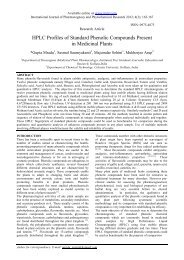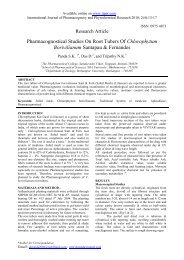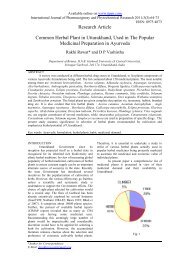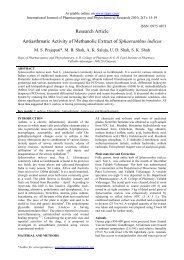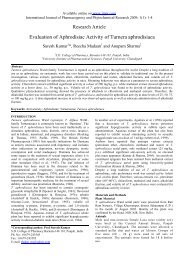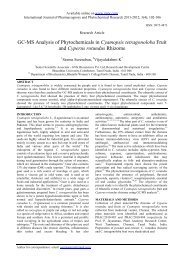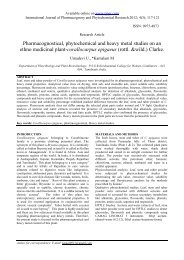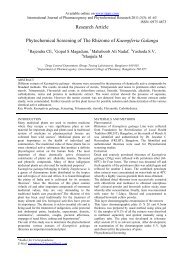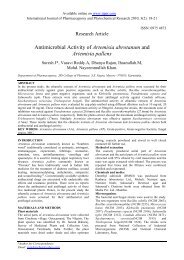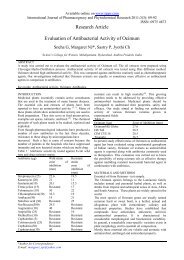Antimicrobial Activity of Stem Bark Extracts of Nyctanthes arbortristis ...
Antimicrobial Activity of Stem Bark Extracts of Nyctanthes arbortristis ...
Antimicrobial Activity of Stem Bark Extracts of Nyctanthes arbortristis ...
You also want an ePaper? Increase the reach of your titles
YUMPU automatically turns print PDFs into web optimized ePapers that Google loves.
Manisha Vats et al. / <strong>Antimicrobial</strong> activity <strong>of</strong> stem bark extracts<br />
Table .1: <strong>Antimicrobial</strong> activity (zone <strong>of</strong> inhibition) <strong>of</strong> stem bark extracts <strong>of</strong> N. <strong>arbortristis</strong> Linn.<br />
<strong>Extracts</strong>/ Standards PE CH ETH Cipro Fluco<br />
Conc.(mg/ml) 10 20 40 50 10 20 40 50 10 20 40 50 5 5<br />
Microorganisms<br />
Zone <strong>of</strong> inhibition (mm)<br />
S. aureus 4 5 8 9 7 9 13 15 1 2 4 5 26 NA<br />
B. subtilis 4 6 7 8 5 6 8 10 - 2 3 5 32 NA<br />
M. luteus 3 5 5 6 6 8 11 16 2 3 6 7 14 NA<br />
P. aeruginosa 4 5 8 7 9 11 14 19 6 8 11 12 25 NA<br />
E. coli 3 4 6 6 8 9 11 13 4 5 6 7 22 NA<br />
C. albicans - - - - 3 6 8 11 - - - - NA 13<br />
A. niger - - - - 4 6 8 10 - - - - NA 14<br />
PE = Petroreum ether extract, CH = Chlor<strong>of</strong>orm extract, ETH = Ethanol extract, Cipro = cipr<strong>of</strong>loxacin, Fluco =<br />
fluconazole, S. aureus = Staphylococcus aureus, B. subtilis = Bacillus subtilis, M. luteus = Micrococcus luteus, P.<br />
aeruginosa= Pseudomonas aeruginosa, E. coli = Escherichia coli, C. albicans = Candida albicans, A.niger = Aspergillus<br />
niger, NA = Not Applicable<br />
MTCC/08/10/5396. The organisms were subcultured onto<br />
nutrient agar in order to determine their viability. The<br />
identity <strong>of</strong> each test organism was confirmed using standard<br />
cultural, morphological and biochemical techniques 9 . Stock<br />
cultures were maintained on nutrient agar slants at 4 o C and<br />
then subcultures in nutrient broth at 37 o C prior to each<br />
antimicrobial test<br />
Zone <strong>of</strong> inhibition (mm)<br />
Zone <strong>of</strong> inhibition <strong>of</strong> stem bark extracts <strong>of</strong> N.<br />
<strong>arbortristis</strong> (50mg)<br />
35<br />
30<br />
25<br />
20<br />
15<br />
10<br />
5<br />
0<br />
S. aureus<br />
B. subtilis<br />
M. luteus<br />
P. aeruginosa<br />
E. coli<br />
C. albicans<br />
Microorganisms<br />
A. niger<br />
PE<br />
CH<br />
ETH<br />
Cipro<br />
Fluco<br />
Graph 1: <strong>Antimicrobial</strong> activity (zone <strong>of</strong> inhibition) <strong>of</strong><br />
stem bark extracts <strong>of</strong> N. <strong>arbortristis</strong> Linn. at a<br />
concentration 50mg/ml<br />
glucose agar (Himedia) was used for the activation <strong>of</strong> the<br />
fungi. Nutrient broth was used for MIC determination.<br />
II. Chemicals for antimicrobial assay Cipr<strong>of</strong>loxacin and<br />
Fluconazole (Central Drug House (P). LTD., New Delhi<br />
110002., India) were used as positive reference standards<br />
(RA) for all bacterial and fungi strains respectively. The<br />
dimethylsulfoxide (DMSO) (Qualigenis) was used as<br />
solvent for the tested samples.<br />
III. Assay method<br />
All the experimentation was done in aseptic area under<br />
laminar air-flow cabinet. The agar diffusion method 10 was<br />
adopted for the study. Broth cultures <strong>of</strong> the test isolates (0.1<br />
ml) containing 1.0 X 10 5 CFU/ml <strong>of</strong> organism was<br />
introduced into a sterile petri dish and 15 ml <strong>of</strong> molten<br />
nutrient agar were added. The content was thoroughly mixed<br />
and then allowed to solidify. The extracts were dissolved in<br />
DMSO and used in concentrations 10, 20, 40 and 50 mg/ml.<br />
Cipr<strong>of</strong>loxacin (5µg/ml) was used as standard for<br />
antibacterial activity and Fluconazole (5µg/ml) was used for<br />
antifungal activity. Holes were bored in the plates, using a<br />
standard sterile cork borer <strong>of</strong> 8 mm diameters and equal<br />
volumes <strong>of</strong> the plant extracts (1000 μl) were transferred into<br />
the wells with the aid <strong>of</strong> micropipette. The experiments were<br />
carried out in triplicate. The plates were kept for 1hr for prediffusion<br />
and incubated at 37°C/24hr (plates containing<br />
bacterial cultures), 25°C/3days (plates containing Candida<br />
albicans culture) and 25°C/7days (for plates containing<br />
Aspergillus niger culture). At the end <strong>of</strong> incubation, zone <strong>of</strong><br />
inhibition was measured in all the plates.<br />
Evaluation <strong>of</strong> antimicrobial activity<br />
I. Culture media Nutrient agar (NA) (Himedia) containing<br />
bromocresol purple was used for the activation <strong>of</strong> Bacillus<br />
IV. Minimum inhibitory concentration (MIC)<br />
It was determined by tube dilution method (turbimetric<br />
method) 11, 12 . 1 ml <strong>of</strong> the sterilized media was poured in the<br />
Table.2: Minimum inhibitory concentration <strong>of</strong> stem bark extracts <strong>of</strong> N. <strong>arbortristis</strong> Linn.<br />
Microorganism<br />
PE<br />
(µg/mL)<br />
CH<br />
(µg/mL)<br />
ETH<br />
(µg/mL)<br />
Cipro<br />
(µg/mL)<br />
Fluco<br />
(µg/mL)<br />
S. aureus 12.5 6.25 12.5 0.625 -<br />
B. subtilis 12.5 6.25 12.5 0.625 -<br />
M. luteus 6.25 6.25 6.25 0.625 -<br />
E. coli 6.25 3.12 6.25 0.312 -<br />
P. aeruginosa 3.12 3.12 3.12 0.312 -<br />
A. niger 12.5 12.5 12.5 - 0.625<br />
C. albicans 12.5 6.26 12.5 - 1.25<br />
species, while NA was used for other bacteria. Sabouraud sterile test tubes. The stock solutions <strong>of</strong> the extracts having<br />
IJPPR September –November, 2009, Vol 1, Issue 1(12-14) 13



